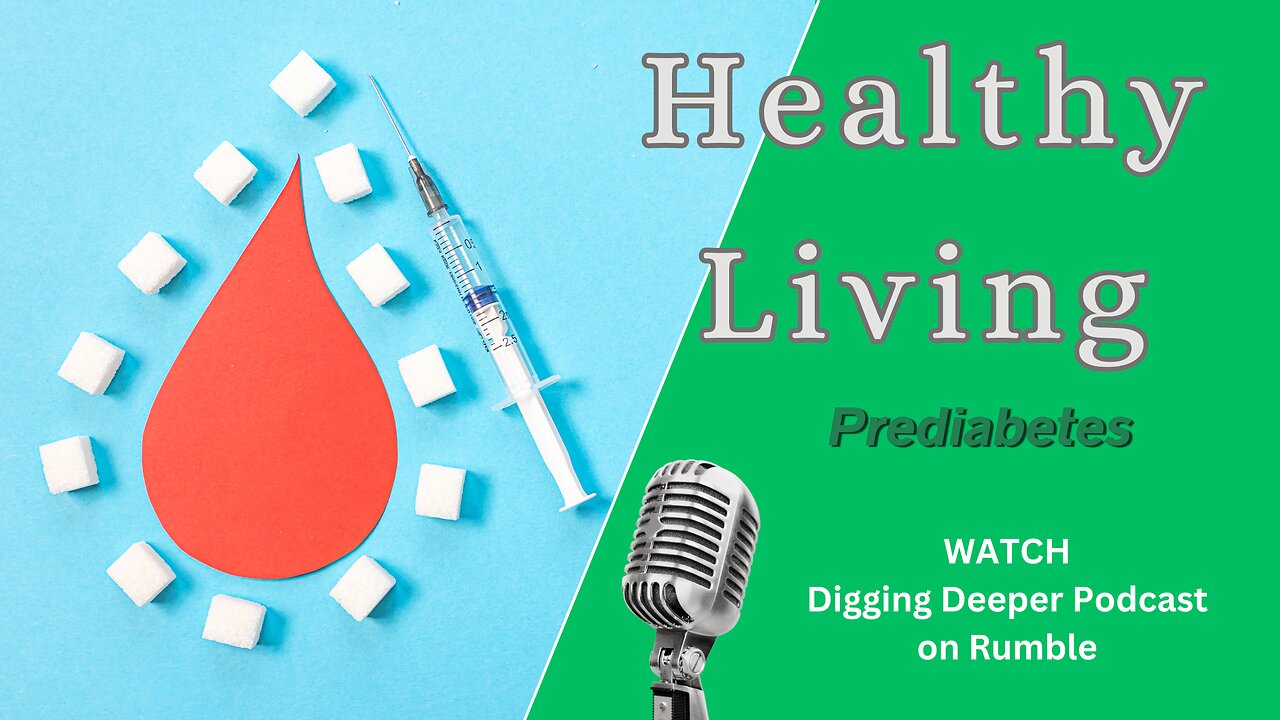Premium Only Content

Healthy Living; Prediabetes Epidemic
Over 80% of people with prediabetes don’t know they have it because they don’t get tested regularly.
Diabetes is a disease in which blood glucose, or sugar, levels are too high. More than nine in 10 cases are type 2 or “adult-onset” diabetes, the kind linked to excess body weight and physical inactivity.
Insulin resistance is when cells in your muscles, fat, and liver can’t use the insulin it makes. As a result, the pancreas produces more insulin to help glucose get into your cells. The CDC relates insulin to a key that lets sugar into cells for use as energy.
One in three adults in the U.S. has prediabetes – that’s about 96 million Americans, according to the Centers for Disease Control and Prevention (CDC). People with prediabetes have high blood sugar levels that can lead to developing type 2 diabetes.
Over 80% of people with prediabetes don’t know they have it because they don’t get tested regularly.
Prediabetes can leave you at risk for type 2 diabetes, heart disease, and stroke. Some good news is that an active lifestyle and weight loss can help prevent or delay serious health problems.
The American Diabetes Association recommends testing for prediabetes and diabetes in adults without symptoms who are overweight and have one or more risk factors. They include:
lack of physical inactivity
parent or sibling with diabetes
family background is African American, Asian American, Hispanic/Latino, Alaska Native, American Indian or Pacific Islander
gestational diabetes or gave birth to a baby who weighed more than 9 pounds
high blood pressure
low high-density lipoprotein (HDL) or “good” cholesterol
high triglyceride levels
polycystic ovary syndrome
impaired fasting glucose or glucose tolerance in previous testing
severe obesity and other conditions associated with insulin resistance
cardiovascular disease
Can I change it?
The good news about a prediabetes diagnosis is that it can be used as warning sign. Prediabetes can allow you to take control of and change your health and habits before it’s too late. Modest lifestyle changes can delay or prevent the onset of type 2 diabetes in prediabetics. These changes can even restore normal blood-glucose levels.
A 5-7% weight loss along with 150 minutes a week of moderate physical activity can reduce the onset of type 2 diabetes in prediabetics by nearly 60%.
If this sounds like a lot, here’s some perspective: For someone who weighs 200 pounds, a 5-7% weight loss means 10-14 pounds. And 150 minutes of exercise can translate into a brisk 30-minute walk, five days a week.
What foods should I eat?
“People with prediabetes do not have to eliminate entire food groups,” she explains. “All foods can fit in the meal plan, and patients should steer clear of fad diets and other strategies that promise quick fixes, since their claims are not supported. We encourage making gradual behavior changes. Small changes can lead to big results.” – Tara Seymour, clinical dietitian and diabetes educator at Johns Hopkins
The ADA’s version of the recommendations suggests these proportions for meals:
50% of the plate filled with nonstarchy vegetables, such as leafy greens
25% with healthy carbohydrates, such as whole grains like brown rice, farro or quinoa
25% with lean protein, such as chicken, turkey, fish or tofu, not fried
Water or another zero-calorie beverage is preferred.
Seymour also recommends:
Avoiding excessive intake of added sugars by limiting sugary beverages, cakes, cookies, candy and snacks
Limiting portion sizes of refined carbohydrate foods such as white bread, white rice and white pasta
Incorporating fiber to reach a goal of 25 to 30 grams per day by eating a variety of fruits, vegetables and whole grains
Limiting saturated and trans fats by choosing lean protein and low-fat dairy
Blood sugar levels are important indications of prediabetes, and it’s no secret that most Americans eat more sugar than they should. Sugar can hide in less obvious places, including processed foods such as breakfast cereals, frozen meals, snacks, sauces and dressings.
Though some sugar is necessary for your body to function, too much can worsen prediabetes. Seymour explains: “Carbohydrates are an important source of energy since glucose [blood sugar] is the preferred molecule to fuel the brain. However, excessive intake of refined carbohydrates from added sugar can cause adverse health effects.
Plant Enzymes Can Turn Sugar to Fiber
The average American consumes about 17 teaspoons of added sugar a day, or 270 calories, well more than the 9 teaspoons for men and 6 teaspoons for women recommended by the American Heart Association.
Harvard University’s Wyss Institute, in a study funded by the Kraft-Heinz Co., found sugar exposed to encapsulated plant enzymes in the gut can be turned into fiber. The finding, if verified, could have a significant impact on an estimated 34.2 million U.S. diabetics.
The enzyme activates only when it encounters a rise in pH “such as that which occurs in the transition from the human stomach to intestine.”
“This could help diabetics, but it would not make eating sugar healthy,” said Amy Shapiro, founder of Real Nutrition NYC. “Many foods that contain sugar also contain artificial colors, flavors, and processed ingredients which makes them unhealthy and can promote other illnesses like high blood pressure, weight gain, and fatigue.”
These enzymes are available under the name 'Transform' at https://www.greengoldnaturalhealing.com
-
 22:28
22:28
Digging Deeper Original Podcasts
3 months agoThe Lord’s Prayer – Total Forgiveness Ch 3.1
1.72K -
 52:57
52:57
Sarah Westall
5 hours agoMAHA the Real Deal or Just a Scam? Behind the Scenes in DC w/ Dr. Sherry Tenpenny
18.5K9 -
 11:03
11:03
Anthony Rogers
9 hours agoSMILE EMPTY SOUL Interview
77 -
 4:48
4:48
Efani: Secure Mobile SAFE Plan
4 days agoIs WiFi Calling Secure? Benefits vs Cons and things to consider
191 -
 18:45
18:45
Lacey Mae ASMR
6 hours agoASMR Tingly Personal Attention and Pampering For Sleep!
32 -
 LIVE
LIVE
MyronGainesX
20 hours ago $3.21 earnedLA Has Fallen! Protestors Takeover And Trump Sends More Troops!
2,290 watching -
 LIVE
LIVE
Razeo
4 hours agoIf I'm not here, I'm there.
237 watching -
 1:41:57
1:41:57
megimu32
3 hours agoON THE SUBJECT: Jock Jams & Space Jam - Soundtracks of Our Childhoods
16.5K5 -
 1:26:56
1:26:56
Glenn Greenwald
7 hours agoFederal Court Dismisses & Mocks Lawsuit Brought by Pro-Israel UPenn Student; Dave Portnoy, Crusader Against Cancel Culture, Demands No More Jokes About Jews; Trump's Push to Ban Flag Burning | SYSTEM UPDATE #466
107K87 -
 2:21:11
2:21:11
RiftTV/Slightly Offensive
6 hours agoSimone Biles Admits DEFEAT Against Riley Gaines, LA Riots RAGE ON | The Rift | Guest: RFH
37K15